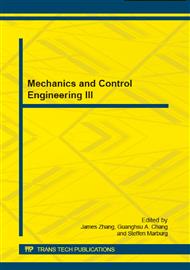p.288
p.293
p.299
p.305
p.313
p.320
p.325
p.329
p.336
Electrorheological Self-Amplifiying Microvalve
Abstract:
This paper presents the design structure of an electrorheological self-amplifying microvalve for electrorheological fluids. This self-amplifying valve can thereby be devided into two main parts, the steering valve and the self-amplifying unit. The first step - combining a conventional electrorheological valve with a self-amplifying unit is one very important aspect and already induced to a promising result in the past. In a next step the conventional electrorheological valve is replaced by an electrorheological microvalve. Smaller dimensions are the final result. The simulation results of the whole system based on measurement results of the electrorheological microvalve are presented in this paper.
Info:
Periodical:
Pages:
313-319
Citation:
Online since:
December 2014
Price:
Сopyright:
© 2015 Trans Tech Publications Ltd. All Rights Reserved
Share:
Citation:


